Jules Verne: Catching the train
Published on January 18th, 2021
(January 18, 2021; Day 9) – After a relatively peaceful two-day transition along the Brazilian coast, the crew of the Maxi Edmond de Rothschild has begun to put some easting into its pursuit of the Jules Verne Trophy, gradually bending the 32-metre giant’s trajectory round towards the point of entry into the Indian Ocean, the Cape of Good Hope.
Very quick over the past four hours with an average speed of over 35 knots at the 07:00 UTC position report, Franck Cammas, Charles Caudrelier and their four crew have also increased their lead over the current record holder to 428 miles this morning. Aboard the flying maxi-trimaran the pace is set to accelerate over the coming hours whilst the temperature will drop as the six sailors plunge towards the southern latitudes.
Since exiting the doldrums on January 15, the six sailors aboard the Maxi Edmond de Rothschild have benefited from mild sailing conditions. They’ve managed to post high speeds on a long sprint on port tack offshore of the Brazilian coast, without forcing things for either the boat or the men.
“We’ve maintained some high average speeds at some points of sail, which aren’t usually synonymous with going so fast,” said Cammas. “We knew that the Maxi Edmond de Rothschild was capable of doing that, but it’s always better to have confirmation of it out on the water. One of the strengths of this flying boat is being swift when sailing close to the wind, as we have been over the past three days.”
Despite the constant speed, the men of Gitana Team have benefited from the ordered seas and warm yet very pleasant temperature to get some rest, whilst also going around the boat, checking the platform and the systems before they dive down towards the Deep South.
After covering more than 5,500 miles over the ground since leaving Ushant, making an average speed of 28 knots, the crew led by Franck Cammas and Charles Caudrelier is about to reach one of the first objectives it had set itself. Indeed, coordinating their connection with a train of austral low-pressure systems is a crucial point for this start to the record and a very tricky section for tackling the Indian Ocean with a competitive time. The six sailors have managed to absolutely nail the timing of this first major appointment.
Position of the Maxi Edmond de Rothschild on 18 January at 06:45 UTC:
Lead in relation to the record: 442.6 nm
Speed: 37.1 knots
Course: 156°
Team information – Tracker – Facebook
Since their start on January 10 at 01:33 UTC, to beat the round the world record of 40:23:30 set in 2017 by Francis Joyon and the crew of Idec Sport, they must finish prior to February 20 at 00:03:15 UTC.
Crew list:
Franck Cammas and Charles Caudrelier, skippers
David Boileau, trimmer/bowman
Erwan Israël, helm/trimmer
Morgan Lagravière, helm/trimmer
Yann Riou, trimmer/media man
Source: Gitana Team
The rules for the Jules Verne Trophy are simple – it is for the fastest time around the world by any type of yacht with no restrictions on the size of the crew, starting and finishing from the exact line between the Le Créac’h Lighthouse off the tip of Brittany and the Lizard Point in Cornwall. It was first won in 1993, with all nine winners as either catamarans or trimarans. The current challenge is to beat the record time of 40 days 23 hours 30 minutes and 30 seconds set by Francis Joyon and crew on the 31.5m IDEC Sport in 2017.
Record Facts
• Start and finish: a line between Créac’h lighthouse (Isle of Ushant) and Lizard Point (England)
• Course: non-stop around-the-world tour racing without outside assistance via the three Capes (Good Hope, Leeuwin and Horn)
• Minimum distance: 21,600 nautical miles (40,000 kilometres)
• Ratification: World Sailing Speed Record Council, www.sailspeedrecords.com
• Time to beat: 40 days, 23 hours, 30 minutes and 30 seconds
• Average speed: 21.96 knots
• Date of current record: January 2017
• Holder: IDEC SPORT, Francis Joyon and a 5-man crew
Split Time References – Full Crew:
Ushant-Equator: 4d 20h 07 ‘(Spindrift 2 in 2019)
Equator-Cape Aiguilles: 6d 08h 55 ‘(Banque Populaire V in 2012)
Cape Aiguilles-Cape Leeuwin: 4d 09h 32 ‘(IDEC Sport in 2017)
Cape Leuuwin-Cape Horn: 9d 08h 46 ‘(IDEC Sport in 2017)
Cape Horn-Equator: 7d 04h 27 ‘(Banque Populaire V in 2012)
Equator-Ushant: 5d 19h 21 ‘(IDEC Sport in 2017)
Here are the nine that have held the trophy:
2017 – Francis Joyon / IDEC SPORT (31.5m) – 40:23:30:30
2012 – Loïck Peyron / Banque Populaire V (40m) – 45:13:42:53
2010 – Franck Cammas / Groupama 3 (31.5m) – 48:07:44:52
2005 – Bruno Peyron / Orange II (36.8m) – 50:16:20:04
2004 – Olivier De Kersauson / Geronimo (33.8m) – 63:13:59:46
2002 – Bruno Peyron / Orange (32.8m) – 64:08:37:24
1997 – Olivier De Kersauson / Sport-Elec (27.3m) – 71:14:22:08
1994 – Peter Blake, Robin Knox-Johnston / Enza New Zealand (28m) – 74:22:17:22
1993 – Bruno Peyron / Commodore Explorer (28m) – 79:06:15:56


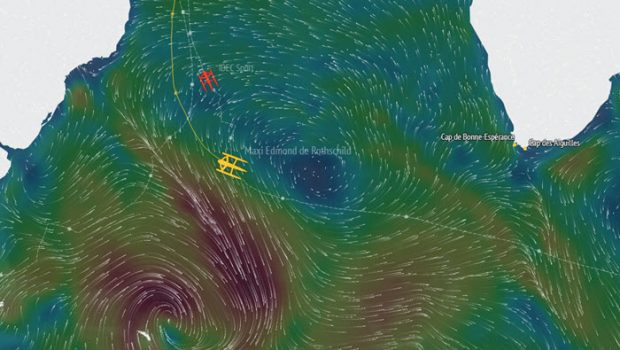


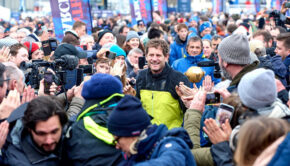
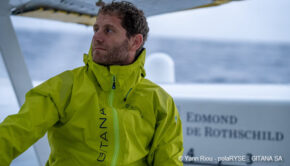
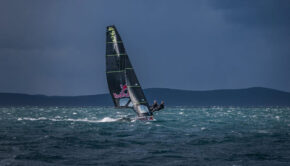
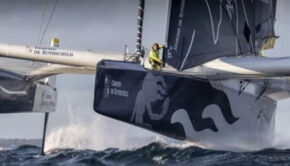
 We’ll keep your information safe.
We’ll keep your information safe.